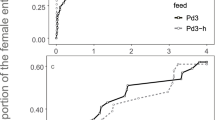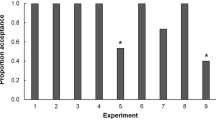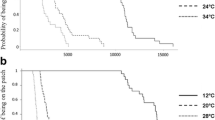Abstract
Charnov’s marginal value theorem predicts that female parasitoids should exploit patches of their hosts until their instantaneous rate of fitness gain reaches a marginal value. The consequences of this are that: (1) better patches should be exploited for a longer time; (2) as travel time between patches increases, so does the patch residence time; and (3) all exploited patches should be reduced to the same level of profitability. Patch residence time was measured in an egg parasitoid Anaphes victus (Hymenoptera: Mymaridae) when patch quality and travel time, approximated here as an increased delay between emergence and patch exploitation, varied. As predicted, females stayed longer when patch quality and travel time increased. However, the marginal value of fitness gain when females left the patch increased with patch quality and decreased with travel time. A. victus females appear to base their patch quality estimate on the first patch encountered rather than on a fixed innate estimate, as was shown for another egg parasitoid Trichogramma brassicae. Such a strategy could be optimal when inter-generational variability in patch quality is high and within-generational variability is low.





Similar content being viewed by others
References
Alphen JJM van, Galis F (1993) Patch time allocation and parasitization efficiency of Asobara tabida, a larval parasitoid of Drosophila. J Anim Ecol 52:937–952
Alphen JJM van, Vet LEM (1986) An evolutionary approach to host finding and selection. In: Waage JK, Greathead D (eds) Insect parasitoids. Academic Press, London, pp 23–54
Alphen JJM van, Bernstein C, Driessen G (2003) Information acquisition and time allocation in insect parasitoids. Trends Ecol Evol 18:81–87
Baaren J van, Boivin G (1998a) Genotypic and kin discrimination in a solitary Hymenopterous parasitoid: implications for speciation. Evol Ecol 12:523–534
Baaren J van, Boivin G (1998b) Learning affects host discrimination behavior in a parasitoid wasp. Behav Ecol Sociobiol 42:9-16
Baaren J van, Boivin G, Nénon JP (1994) Intra- and interspecific host discrimination in two closely related egg parasitoids. Oecologia 100:325–330
Baaren J van, Boivin G, Nénon JP (1995) Intraspecific hyperparasitism in a primary hymenopteran parasitoid. Behav Ecol Sociobiol 36:237–242
Bernstein C, Kecelnik A, Krebs JR (1988) Individual decisions and the distribution of predators in a patchy environment. J Anim Ecol 57:1007–1026
Boivin G (1988) Laboratory rearing of Anaphes sordidatus (Girault) (Hymenoptera: Mymaridae) on carrot weevil eggs (Coleoptera: Curculionidae). Entomophaga 33:131–134
Boivin G (1994) Overwintering strategies of egg parasitoids. In: Wajnberg E, Hassan SA (eds) Biological control with egg parasitoids. CAB, Wallingford, pp 219–244
Boivin G (1999) Integrated management for carrot weevil. Integr Pest Manage Rev 4:21–37
Boivin G, van Baaren J (2000) The role of larval aggression and mobility in the transition between solitary and gregarious development in parasitoid wasps. Ecol Lett 3:469–474
Charnov EL (1976) Optimal foraging, the marginal value theorem. Theor Popul Biol 9:129–136
Cloutier C, Bauduin F (1990) Searching behavior of the aphid parasitoid Aphidius nigripes (Hymenoptera: Aphidiidae) foraring on potato plants. Environ Entomol 19:222–228
Collett D (1994) Modelling survival data in medical research. Chapman & Hall, London
Cook RM, Hubbard SF (1977) Adaptive searching strategies in insect parasites. J Anim Ecol 46:115–125
Cox DR (1972) Regression models and life tables. Biometrics 38:67–77
Cox DR (1975) Partial likelihood. Biometrika 62:269–276
Cronin JT (2003) Patch structure, oviposition behavior, and the distribution of parasitism risk. Ecol Monogr 73:283–300
Cronin JT, Strong DR (1999) Dispersal-dependent oviposition and the aggregation of parasitism. Am Nat 154:23–36
Driessen G, Bernstein C, van Alphen JJM, Kacelnik A (1995) A count-down mechanism for host search in the parasitoid Venturia canescens. J Anim Ecol 64:117–125
Giraldeau L, Kramer DL (1982) The marginal value theorem: a quantitative test using load size variation in a central place forager, the eastern chipmunk, Tamias striatus. Anim Behav 30:1036–1042
Godfray HCJ (1994) Parasitoids. Behavioral and evolutionary ecology. Princeton University Press, Princeton, N.J.
Hubbard SF, Cook RM (1978) Optimal foraging by parasitoid wasps. J Anim Ecol 47:593–604
Iwasa Y, Higashi M, Yamamura N (1981) Prey distribution as a factor determining the choice of optimal foraging strategy. Am Nat 117:710–723
Kacelnik A (1984) Central place foraging in starlings (Sternus vulgaris). I. Patch residence time. J Anim Ecol 53:283–299
Kalbfleisch JD, Prentice RL (1980) The statistical analysis of failure time data. Wiley, New York
Li C, Roitberg BD, Mackauer M (1993) Patch residence time and parasitism of Aphelinus asychis: a simulation model. Ecol Model 69:227–241
McNamara JM, Houston AI (1985) Optimal foraging and learning. J Theor Biol 117:231–249
Nelson JM, Roitberg BD (1995) Flexible patch time allocation by the leafminer parasitoid, Opius dimidiatus. Ecol Entomol 20:245–252
Nénon JP, Boivin G, Le Lannic J, van Baaren J (1995) Functional morphology of the mymariform and sacciform larvae of the egg parasitoid Anaphes victus Huber (Hymenoptera: Mymaridae). Can J Zool 73:996–1000
Picard C, Auclair JL, Boivin G (1991) Response to host age of the egg parasitoid Anaphes n.sp. (Hymenoptera: Mymaridae). Biocontr Sci Tech 1:169–176
Pierre J-S, van Baaren J, Boivin G (2003) Patch leaving decision rules in parasitoids: do they use sequential decisional sampling? Behav Ecol Sociobiol 54:147–155
Roitberg BD, Reid ML, Li C (1993a) Choosing hosts and mates: the value of learning. In: Papaj DR, Lewis AC (eds) Insect learning: ecological and evolutionary perspectives. Chapman & Hall, New York, pp 174–194
Roitberg BD, Sircom J, Roitberg CA, van Alphen JJM, Mangel M (1993b) Life expectancy and reproduction. Nature 364:108
Stephens DW (1993) Learning and behavioral ecology: incomplete information and environmental predictibility. In: Papaj DR, Lewis AC (eds) Insect learning: ecological and evolutionary perspectives. Chapman and Hall, New York, pp 195–218
Stephens DW, Krebs JR (1986) Foraging theory. Princeton University Press, Princeton, N.J.
Strand MR, Vinson SB (1982) Behavioral response of the parasitoid Cardiochiles nigriceps to a kairomone. Entomol Exp Appl 31:308–315
Venables WN, Ripley BD (1994) Modern applied statistics with S-Plus. Springer, Berlin Heidelberg New York
Vos M, Hemerik L, Vet LEM (1998) Patch exploitation by the parasitoids Cotesia rubecula and Cotesia glomerata in multi-patch environments with different host distribution. J Anim Ecol 67:774–783
Waage JK (1979) Foraging for patchily-distributed hosts by the parasitoid, Nemeritis canescens. J Anim Ecol 48:353–371
Wajnberg E, Rosi MC, Colazza S (1999) Genetic variation in patch time allocation in a parasitic wasp. J Anim Ecol 68:121–133
Wajnberg E, Fauvergue X, Pons O (2000) Patch leaving decision rules and the marginal value theorem: an experimental analysis and a simulation model. Behav Ecol 11:577–586
Wajnberg E, Gonsard PA, Tabone E, Curty C, Lezcano N, Colazza S (2003) A comparative analysis of patch-leaving decision rules in a parasitoid family. J Anim Ecol 72:618–626
Wiskerke JSC, Vet LEM (1994) Foraging for solitary and gregariously feeding caterpillar: a comparison of two related parasitoid species (Hymenoptera: Braconidae) J Insect Behav 7:585–603
Acknowledgements
This work was supported in part by research grants from NSERC to G. B. and the MRI/INRA (M. B. Charpentier). We thank D. Thibodeau for her technical assistance and C. Bernstein and B. Roitberg for their comments on an earlier version of the manuscript. This is contribution 335/2003.09.01R of the CRDH, Agriculture et Agroalimentaire Canada, St-Jean-sur-Richelieu, Quebec. This work is also part of GDR 2155 Ecologie Comportementale (CNRS commission 30). These experiments comply with the current laws of Canada.
Author information
Authors and Affiliations
Corresponding author
Rights and permissions
About this article
Cite this article
Boivin, G., Fauvergue, X. & Wajnberg, E. Optimal patch residence time in egg parasitoids: innate versus learned estimate of patch quality. Oecologia 138, 640–647 (2004). https://doi.org/10.1007/s00442-003-1469-z
Received:
Accepted:
Published:
Issue Date:
DOI: https://doi.org/10.1007/s00442-003-1469-z




